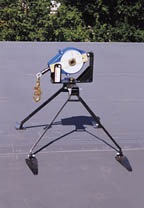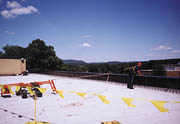Roof Anchor Points

According to the American National Standards Institute, the lanyard must create this inverse ratio of resistance/mass to result in a final, maximum impact force of 1,800 pounds at full deployment of 9 feet, 6 inches. This decelerated impact force is equal to that same 180-pound worker falling almost 2 feet with a non-shock-absorber lanyard. With a final impact within seconds of falling, this force is still a considerable shock to the body.
An ANSI-approved full-body harness is designed to distribute these applied end-forces uniformly around the worker’s body. If a worker reaches impact in almost any position, except total inversion, the harness will concentrate the impact forces at the pelvic girdle. This anatomical area is heavily reinforced with large bone structure and muscle mass and devoid of most life-support organs, unlike the thoracic region. It is critical for the harness to be adequately fit-tested to the worker and properly adjusted prior to use in maximizing its effectiveness.
For roofing contractors, the final component of the PFAS is an adequately designed and effectively selected roof anchor point, capable of resisting all applied gross-impact forces. Of all the PFAS components, the anchor point is the only one that is not entirely self-contained and requires a site-specific structural evaluation. Regardless of the type and manufacturer of an anchoring device, it is the Qualified Person’s responsibility to design the anchoring system and verify a minimum safety factor of 2x for every installation and reinstallation.
The reason most PFAS that fail do so at, or in conjunction with, the anchor point is that the safety factor of the anchor point is often determined by qualitative rather than quantitative methods. Those inadequate anchor points that do NOT fail minimum-strength requirements are usually NOT simultaneously stressed by all potential forces. Their safety factor, while less than 2x potential, or 10,000 pounds, may have been adequate to prevent gross failure. Concerning anchor points, OSHA’s Subpart M Fall Protection standard (1926.502(d)(15)) states:
“Anchorages used for attachment of personal fall arrest equipment shall be independent of any anchorage being used to support or suspend platforms and capable of supporting at least 5,000 pounds per employee attached or shall be designed, installed and used as follows:
as part of complete personal fall arrest systems which maintain a safety factor of at least two, and
under supervision of a qualified person.”

Evaluating the Anchor Points
Anchor point selection is such an important stage of the system assembly that the qualified person should thoroughly and accurately calculate, document and log this procedure. Due to the probability of human error or omission, anchor point logs should be seriously undertaken. The qualified person’s signature at the bottom of the anchor point log indicates his sole responsibility. Some of the more important evaluations that may be considered include:Angle of Incidence: How forces are applied to the actual anchoring device and its substructure can effect its terminal strength. Seldom are falls made vertically. Often the fall victim has rolled or slid off a sloped plane, converting his free fall into a curve with asymptotic behaviors. He may reach initial impact while in this curve, stressing the anchoring device, its fasteners or the sub-structure in a direction in which it is not fully capable of resistance.
Rebound forces: Nylon lifelines, lanyards and harnesses are designed to stretch and elongate, absorbing a significant amount of energy. A rebound is the reverse action of impact. In a laboratory, this force would result in a diminished impact at a complementary angle to the first impact angle of incidence. Often, onsite falls may have several rebounds and involve various force angles.
Entanglements: Some of my PFAS test-drops have involved a dummy load either snagging or wrapping around horizontal and vertical structures. In some of these cases, the dynamic line load, instead of reaching impact and relaxing, is held static and this constant load may contribute to anchor point failure. Many entanglements may also involve sharp or abrasive edges that can cut or damage a lifeline, causing it to fail.
Fastening devices: The strength of an anchoring device is intrinsic with its least fastening device, such as a screw, bolt/nut or weld. What is its maximum breaking strength both in the lateral (shear) and axial (tension) directions? Welding should be thoroughly prepared and carefully performed by a certified welder. In some cases, welds should be visually inspected and tested by non-destructive methods. Bolts, nuts and washers should be rated for at least 10 Kips tensile strength and inspected regularly for condition and tight fit.
Substructure: Whether attaching a nylon cross-arm strap to a beam, welding a steel-pad eye to a column or clamping a support frame to the ridge for a retractable lifeline, an evaluation must be made of the existing structure as to:
Simultaneous live and dead loads already being applied to the structure before the anchor point is applied.
Method of load application, either uniform, eccentric or point loaded.
Down-rating the materials deflection and tensile strength from new to existing condition. New material data is available from such sources as the Steel Institute’s handbook, pipefitter’s handbook, or Western Wood Products manual. The qualified person should determine by what percentage these initial strength values should be reduced.
Reviewing previous anchor point logs before another PFAS job is bid may facilitate the planning and implementation stages of the upcoming job. As regards to planning, OSHA’s Subpart M, Fall Protection standard Appendix C, section (h) states:
“Probably the most overlooked component is planning for suitable anchorage points. Such planning should ideally be done before the structure or building is constructed so that anchorage points can be incorporated during construction for use later … Properly planned anchorages should be used if they are available. In some cases, anchorages must be installed immediately prior to use. In these instances, a registered professional engineer with experience in designing fall protection systems or another qualified person with appropriate education and experience should design an anchor point to be installed.”
Keep in mind that the last component of the PFAS to receive any forces is the anchor point. The last portion of the anchor point to be stressed is the substructure to which it is attached. Whenever an anchor point’s structure cannot be completely observed or its integrity evaluated, the qualified person should always incorporate a back-up anchor and redundant lifeline whenever there is any question of the anchor point’s integrity.
Some of those structures that should never be considered suitable for anchorage include: conduits and cable trays; pipes and support racks; scaffolding and scaffolding supports; suspended platforms; guardrails, hand rails and wood trusses (unless specifically designed for anchor points); cranes and hoists; vent stacks; structures with sharp, abrasive edges; any structure that cannot be evaluated.
OSHA’s Subpart M, Fall Protection standard, Appendix C, section (h)(ii) also states: “In some cases … there will be a need to devise an anchor point from existing structures. Examples of what might be appropriate anchor points are: steel members or I beams, if an acceptable strap is available for the connection; large eye bolts made of appropriate grade steel; guardrails or railings if they have been designed for use as an anchor point; masonry or wood members if attachment points are substantial and precautions are taken that bolts/connectors will not pull through or release. A qualified person should evaluate and log these makeshift anchorages.”
Anchor point selection, preparation and installation is a time-consuming and costly practice if done properly. In most PFAS, there are usually multiple anchor points to be established, often in sequential utilization. Qualified personnel with ample training and experience are required to ensure the anchor installations are well planned and implemented.
The detailed documentation of an anchor point log may protect against liabilities and can usually be added to expenses. Remember: Safety begins in the bid documents. If it’s in the proposed budget, it may reach the job site. If it isn’t, it never will.
New Products
In the last 10 years, the fall safety industry has seen an increased demand for flexible, practical and affordable anchor point devices in the construction market. Manufacturers have responded with advanced and sometimes innovative products. Lifelines, lanyards, connectors and harnesses have seemingly all been invented, improved and accessorized to meet contractor demands and fit almost any budget.In relation to those components of the PFAS, however, new and innovative AP devices are relatively few. For roofing contractors, it is obviously one of the most difficult problems to solve. For instance, while almost all ANSI-approved harnesses and lanyards will be adequate for most roofing jobs, not all anchor points may be sufficient.
The fall protection training and experience of roofers also varies, seriously impacting most anchor point installations. Not all roofing jobs use the skills of a registered professional engineer to custom design or approve anchor points for all the workers onsite. It is a tragic fact that the most likely point of system failure often has the least qualified workers making crucial decisions.
Next month, I will review four of the most innovative anchor point devices that I have recently encountered in the roofing industry.
Looking for a reprint of this article?
From high-res PDFs to custom plaques, order your copy today!


